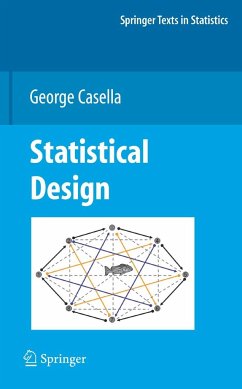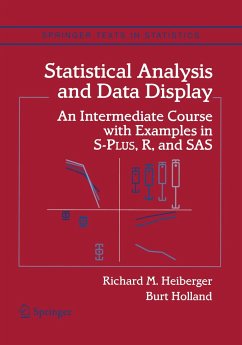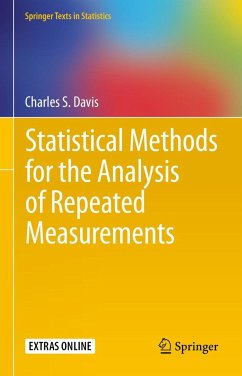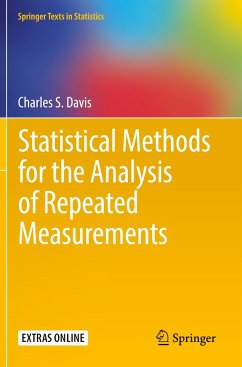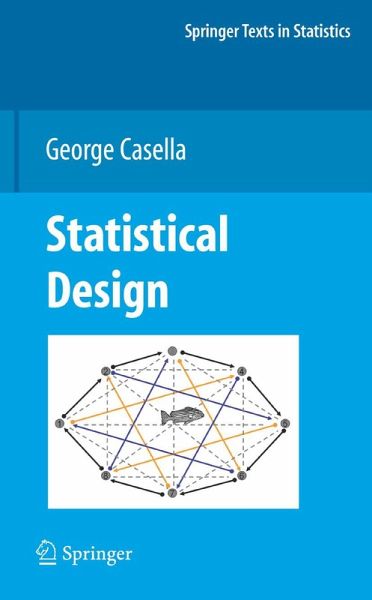
George Casella
Gebundenes Buch
Statistical Design
Versandkostenfrei!
Versandfertig in 6-10 Tagen
Weitere Ausgaben:

PAYBACK Punkte
53 °P sammeln!




Statistical design is one of the fundamentals of our subject, being at the core of the growth of statistics during the previous century. Design played a key role in agricultural statistics and set down principles of good practic, principles that still apply today. Statistical design is all about understanding where the variance comes from, and making sure that is where the replication is. Indeed, it is probably correct to say that these principles are even more important today.
Produktdetails
- Springer Texts in Statistics
- Verlag: Springer / Springer New York / Springer, Berlin
- Artikelnr. des Verlages: 12121052, 978-0-387-75964-7
- 2008
- Seitenzahl: 336
- Erscheinungstermin: 3. April 2008
- Englisch
- Abmessung: 241mm x 160mm x 23mm
- Gewicht: 660g
- ISBN-13: 9780387759647
- ISBN-10: 0387759646
- Artikelnr.: 23307197
Herstellerkennzeichnung
Libri GmbH
Europaallee 1
36244 Bad Hersfeld
gpsr@libri.de
From the reviews:
"In an era where many design texts present a wide collection of tools and practical considerations for creating designs, this book is a marked contrast with a primary focus on developing a thorough understanding of the core of design theory.... The book is an excellent reference for those already familiar with design of experiments, because of its careful and detailed presentation of core designs and how to verify that an appropriate analysis is chosen to match the structure of how the data were collected. In addition it contains numerous nuggets of wisdom about potential pitfalls from inattention to detail.... Overall, the style of the book gives a clear, understandable presentation of the formal details of
"In an era where many design texts present a wide collection of tools and practical considerations for creating designs, this book is a marked contrast with a primary focus on developing a thorough understanding of the core of design theory.... The book is an excellent reference for those already familiar with design of experiments, because of its careful and detailed presentation of core designs and how to verify that an appropriate analysis is chosen to match the structure of how the data were collected. In addition it contains numerous nuggets of wisdom about potential pitfalls from inattention to detail.... Overall, the style of the book gives a clear, understandable presentation of the formal details of
Mehr anzeigen
statistical design for many core design types for balanced data involving categorical factors. The mathematical detail and rigor of the text allows students the opportunity to form a firm foundation on which to build their understanding and intuition about this important area. (Christine ANDERSON-COOK, JASA, June 2009, Vol. 104, No. 486)
"The goal is to describe the principles that drive good design, which are also the principles that drive good statistics'. ... Casella succeeds exceptionally well to reach his goals. I greatly enjoyed browsing through this book. The author's experience and writing skills together make this an excellent course book. Concepts are presented in a very reader-friendly and instructive way. ... The layout of the book, huge amount of examples, and very clear writing make this a book highly recommended for anyone interested in statistical design." (Simo Puntanen, International Statistical Review, Vol. 76 (3), 2008)
"Overall, I found reading this book to be worthwhile. I particularly think the author's discussion of blocking is quite interesting as well as the discussion of loop designs versus balanced incomplete block designs. In fact, I intend to use this book assupplementary reading material for my own design course." (Biometrics, December 2008)
"The level of this text is for the first or second year graduate students and, the material is about right for a one-semester course. The chapters cover, for the most part, the standard material of a book on designs, with mostly real examples, and applications of designs in real situations. ... This is an important book permitting to understand statistical designs." (T. Postelnicu, Zentralblatt MATH, Vol. 1181, 2010)
"This book is a graduate-level text on the design of experiments. It is the product of the author's statistical consulting experience as well as his experience teaching statistical design. It is intended for use in a one-semester course with first- or second-year graduate students who are familiar with standard statistical methods such as analysis of variance (ANOVA), blocking, and multiple regression. ... is worth considering for a graduate course in design for students with a good mathematical statistics background." (William I. Notz, Mathematical Reviews, Issue 2011 k)
"This is one of the most simple and clearly written experimental design books ... . technical notes at the end of most of the chapters are great ways to let students understand the foundation of the materials conveyed in the book. ... Readers can quickly search information, discussions, comments, and answers to questions at the end of the chapters. ... Overall, the book seems thin, but it does include important information about statistical design. ... I enjoy reading this well-explained book." (Keying Ye, Technometrics, Vol. 52 (4), November, 2010)
"The goal is to describe the principles that drive good design, which are also the principles that drive good statistics'. ... Casella succeeds exceptionally well to reach his goals. I greatly enjoyed browsing through this book. The author's experience and writing skills together make this an excellent course book. Concepts are presented in a very reader-friendly and instructive way. ... The layout of the book, huge amount of examples, and very clear writing make this a book highly recommended for anyone interested in statistical design." (Simo Puntanen, International Statistical Review, Vol. 76 (3), 2008)
"Overall, I found reading this book to be worthwhile. I particularly think the author's discussion of blocking is quite interesting as well as the discussion of loop designs versus balanced incomplete block designs. In fact, I intend to use this book assupplementary reading material for my own design course." (Biometrics, December 2008)
"The level of this text is for the first or second year graduate students and, the material is about right for a one-semester course. The chapters cover, for the most part, the standard material of a book on designs, with mostly real examples, and applications of designs in real situations. ... This is an important book permitting to understand statistical designs." (T. Postelnicu, Zentralblatt MATH, Vol. 1181, 2010)
"This book is a graduate-level text on the design of experiments. It is the product of the author's statistical consulting experience as well as his experience teaching statistical design. It is intended for use in a one-semester course with first- or second-year graduate students who are familiar with standard statistical methods such as analysis of variance (ANOVA), blocking, and multiple regression. ... is worth considering for a graduate course in design for students with a good mathematical statistics background." (William I. Notz, Mathematical Reviews, Issue 2011 k)
"This is one of the most simple and clearly written experimental design books ... . technical notes at the end of most of the chapters are great ways to let students understand the foundation of the materials conveyed in the book. ... Readers can quickly search information, discussions, comments, and answers to questions at the end of the chapters. ... Overall, the book seems thin, but it does include important information about statistical design. ... I enjoy reading this well-explained book." (Keying Ye, Technometrics, Vol. 52 (4), November, 2010)
Schließen
Für dieses Produkt wurde noch keine Bewertung abgegeben. Wir würden uns sehr freuen, wenn du die erste Bewertung schreibst!
Eine Bewertung schreiben
Eine Bewertung schreiben
Andere Kunden interessierten sich für




